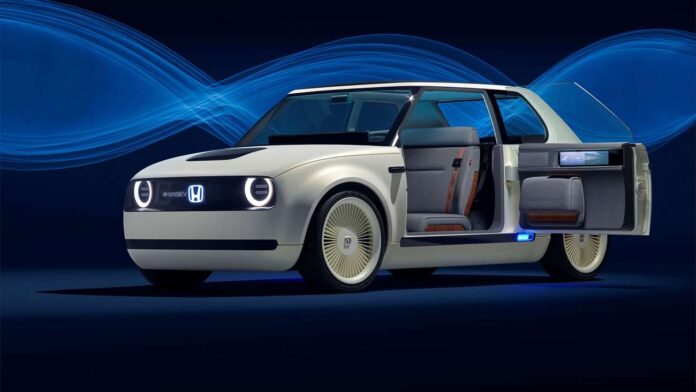Honda J-VX 1997
We’ve written about the J-VX before on our list of nine quirky Japanese concept cars we wish were built, and our opinion on it hasn’t changed: we love it. It looks like the product of a love affair between a Lamborghini and a Honda, with those superb scissor doors and bright green paint. It was the world’s first hybrid sportscar too, with a 1.0-litre three-cylinder engine paired with a supercapacitor. The J-VX never made it to production, but the concept it morphed into, the VV, became the Honda Insight. Now we’re trying to imagine a Honda Insight with scissor doors.
Honda EV-N 2009
If you’re a car enthusiast, and if you’re reading this then you more than likely are, you’ll have heard the term ‘Kei car’. For those of you who haven’t, Kei cars are the smallest and least powerful cars available to buy in Japan. Originally created a few years after the end of the Second World War when many cars were too expensive and too large, and motorcycles, therefore, were the personal transport solution of choice, Kei cars had to adhere to strict maximum size and maximum power and displacement rules. As a result they could be bought, parked and driven in places that normal cars could not and for a lot less money.
If you were looking for a modern-ish interpretation of one of Honda’s earliest cars, the 1967 N360 Kei car, then the Honda EV-N was it. Measuring just under 2.8m long (a Ford Fiesta, for reference, is more than 4m long) the EV-N, Honda claimed, could comfortably fit four adults, two of whom could whiz off on Honda U3-X, self-balancing, single-wheeled ‘personal mobility devices’, with one attached to the inside of each of the doors. An EV designed for the city, the roof was plastered with solar panels to give a free energy boost when the car was parked. An odd-ball, yes, but we quite like it.
Honda Urban EV
If the EV-N was a good retro-styled EV, the Urban EV concept was truly excellent. Unveiled at the 2017 Frankfurt Motor Show, this is the car that went on to become the glorious Honda e. As a concept, however, the car’s designers could do things that wouldn’t be possible when it came to finally make the production version – the pillars were thin, the wheels ginormous, the arches flared.
What’s brilliant, though, is that so many elements of the Urban EV made it to the Honda E. The dashboard of screens, the side-mirror cameras, the boxy shape and the frameless windows, all elements that would have been so easy to discard going from concept to reality. But it wasn’t the only EV that Honda unveiled in 2017.
Analysis
Concept cars are most often used to explore a companies future capabilites as well as depict the stylisitc elements they will probably be using in their future models. I think it’s interesting that Honda was at the forefront of developing EVs with their hybrid concept and later their hybrid vehicles. It signaled early on the interest of car companies in EV technology. Concept cars are also important because they are the result of car companies developing speicific features in their cars for a specific market or country.
Source
Ward, Seán. “The Eleven Best Honda Concept Cars (List): GRR.” Goodwood, 30 Nov. 2020, https://www.goodwood.com/grr/road/news/2020/11/the-eleven-best-honda-concept-cars/.




